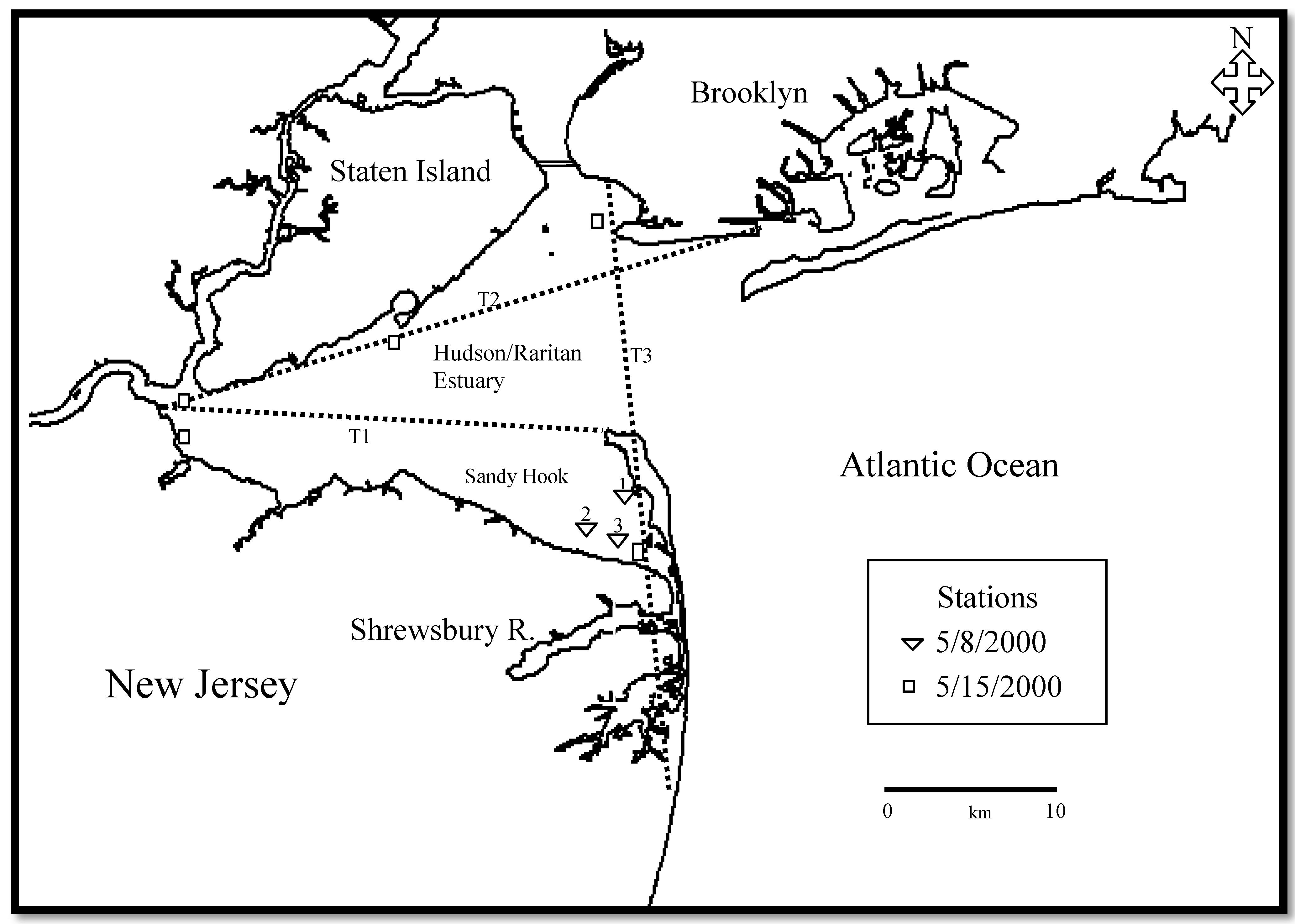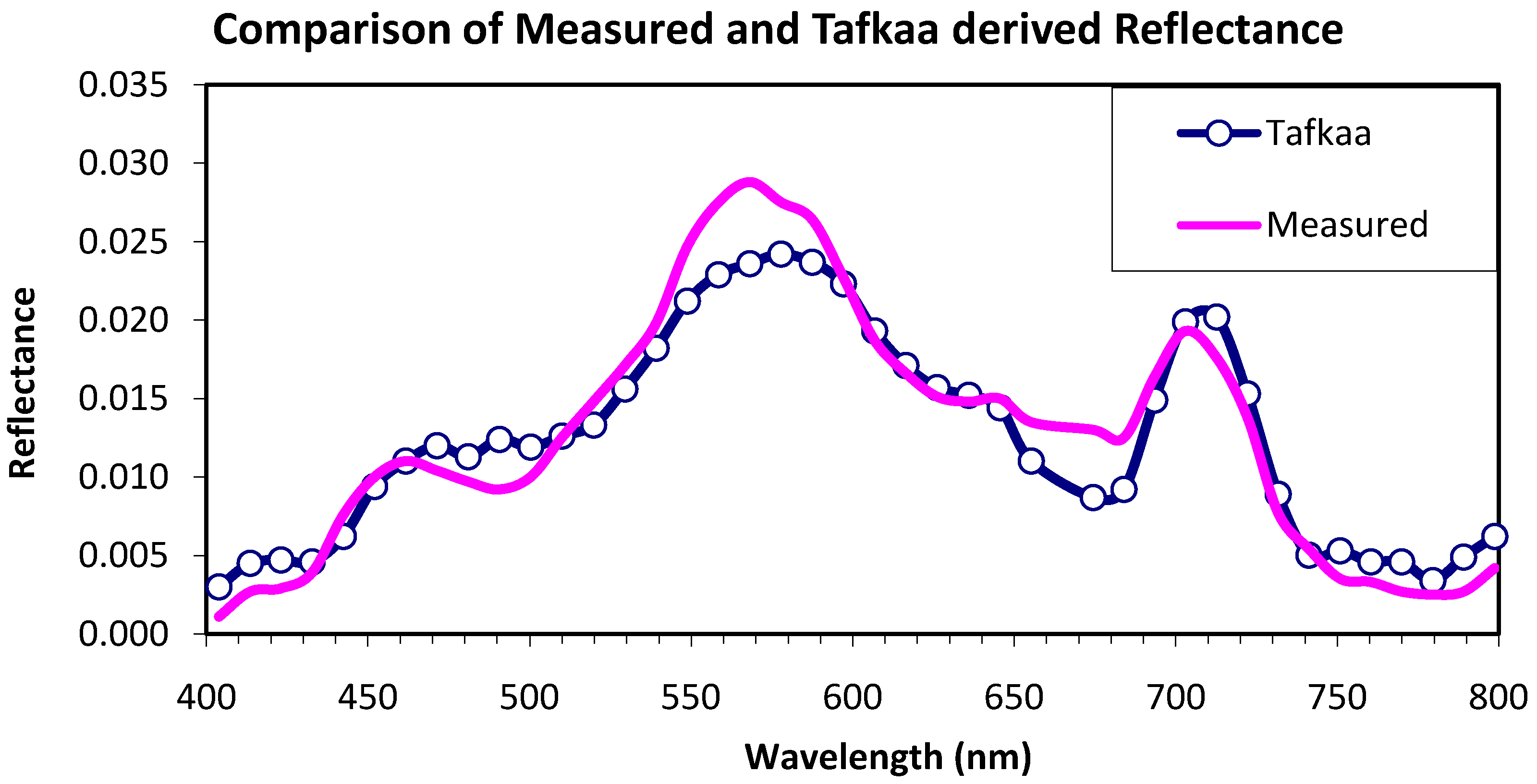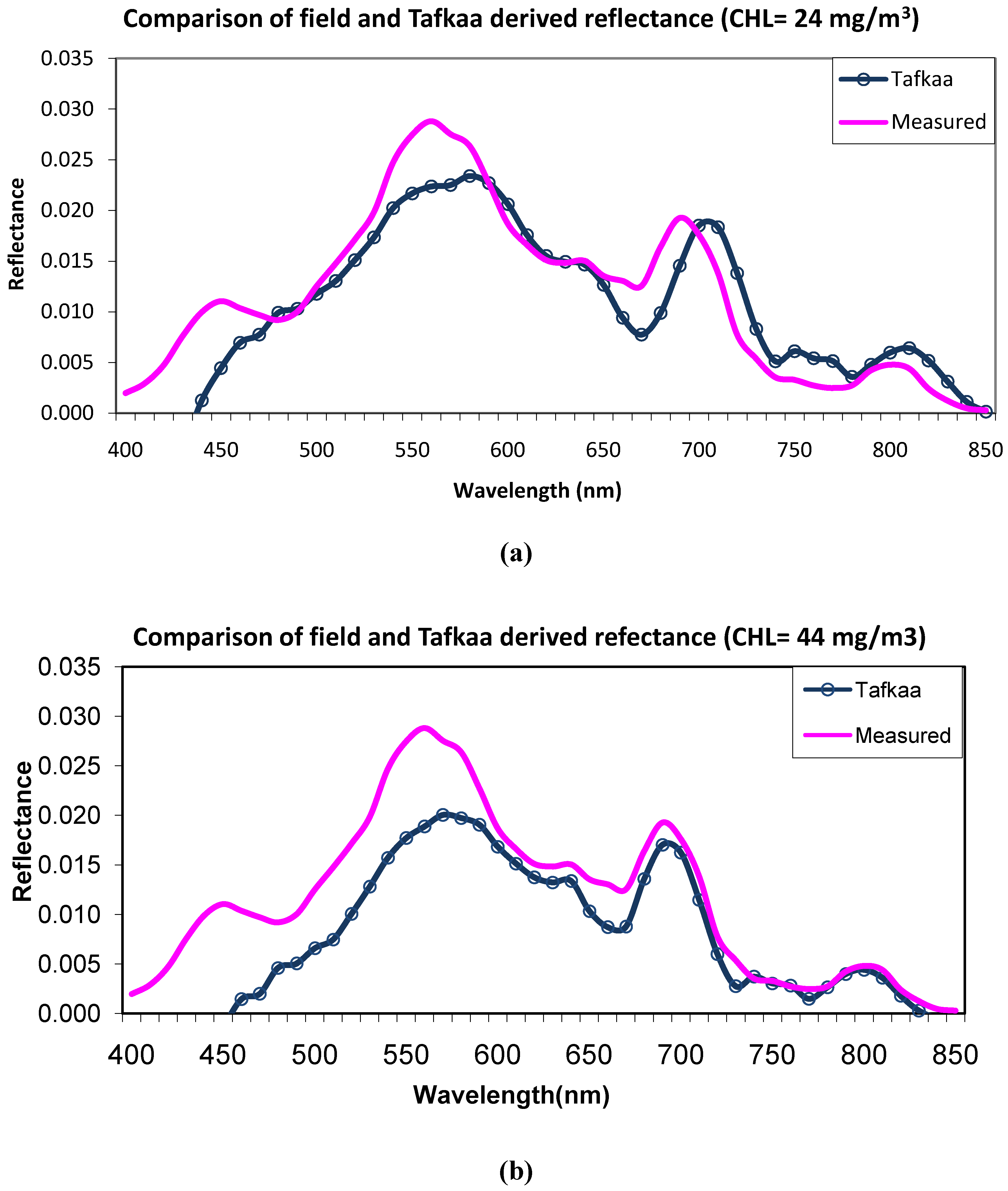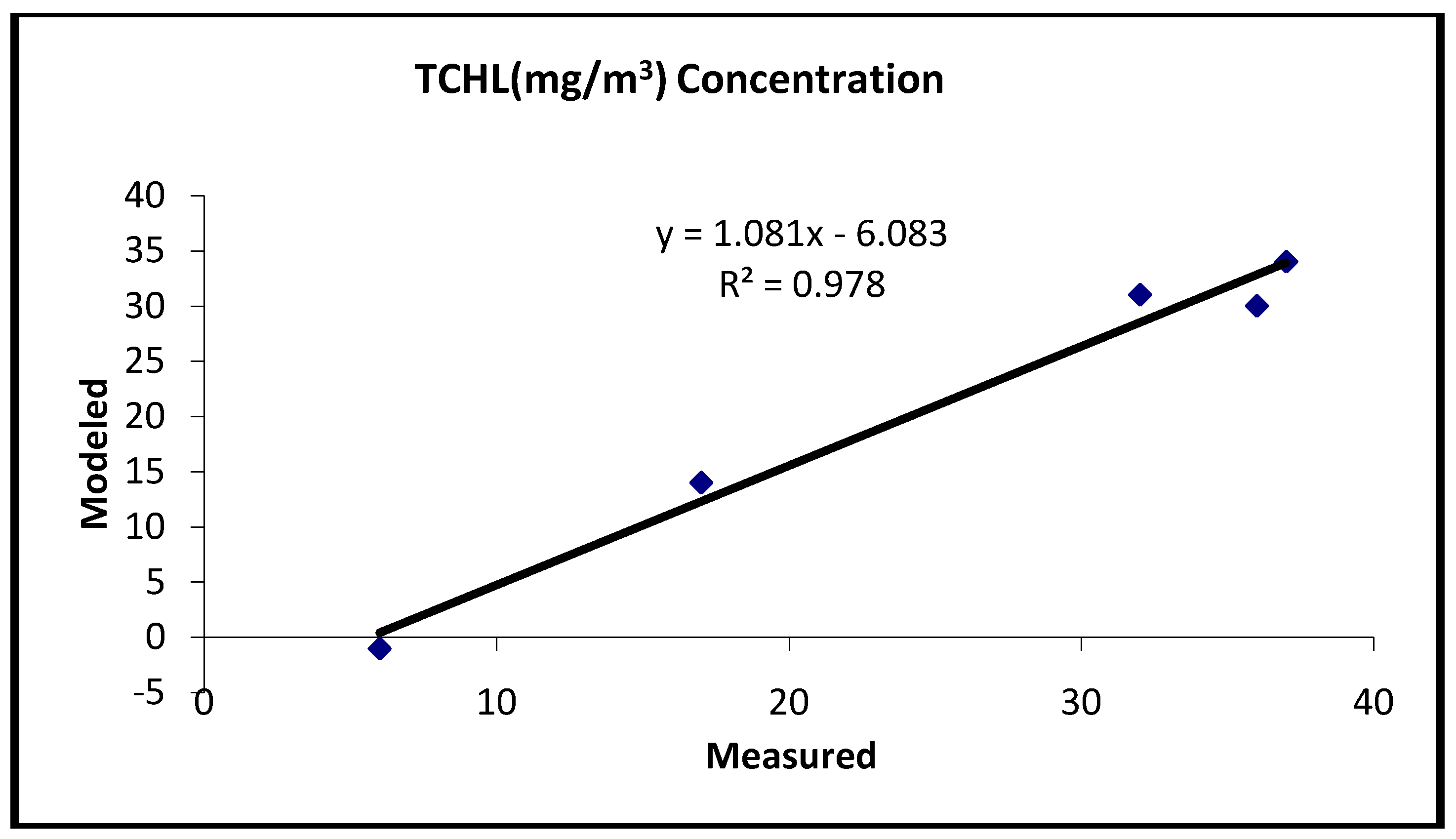Nearshore Water Quality Estimation Using Atmospherically Corrected AVIRIS Data
Abstract
:1. Introduction
2. Materials and Methods
2.1. Study Area

2.2. Sensors and Data Characteristics
2.2.1. AVIRIS
| Sensor Design | Whisk broom, 4 spectrometers |
| Platform | Airborne ER-2 @~20 km |
| Spectral Characteristics | 224 bands, ∆λ ~ 10 nm, FWHM ~ 10 nm, range 375–2,500 nm |
| Typical GSD | ~20 m from ER-2 |
| Full field of view | 30° (~12 km at ER-2 altitude) |
| SWIR Characteristics | Relatively high SNR |
2.2.2. Field Spectroradiometer—OL 754
2.2.3. Shipboard Samplings
2.2.4. Inherent Optical Properties (IOPs)
2.3. Bio-Optical Model
- aw = absorption of pure water,
- bw = scattering of pure water,
- a*ph = specific absorption of the phytoplankton,
- bb*TSM = specific backscatter of TSM (Total Suspended Material),
- a*TSM = specific absorption of TSM,
- 0.5 = backscatter to scatter ratio of pure water,
- a*CDOM = specific absorption of CDOM (Color Dissolved Organic Matter).
2.4. Atmospheric Correction
| Parameter | Parameterization | Source |
|---|---|---|
| Input radiance data cube | Image centre latitude = 40°44′00″ Image centre longitude = 73°53′50″ | AVIRIS Jet Propulsion Laboratory |
| Cloud mask | NDVI > 0.05 | AVIRIS Input data cube |
| Atmospheric Model | Mid-Latitude Summer | Selected from MODTRAN standard models (based on the surface temperatures) |
| Ozone | 0.325 | Acquired from Earth Probe TOMS (Total Ozone Mapping Radiometer) |
| Atmospheric Gases | H2O, CO2, O3, CO, CH4, O2 | Tafkaa options |
| Geometry | Single nadir viewing: Image centre zenith angle = 45°00′00″ | Calculated from AVIRIS header data |
| Image centre azimuth angle = 194°00′00″ | ||
| Aerosol method | Pixel-by-pixel | Tafkaa options |
| Aerosol model | Coastal | Selected from MODTRAN standard models based on geography of the scene |
| Relative Humidity | 80% | Tafkaa options (selection on the basis of weather of the day) |
| Aerosol wavelengths | 0.86, 1.04 | Tafkaa options (selection based on the quality of the radiance cube. excluding noisy bands) |
| Exclude aerosol model | none | Tafkaa options (based on the scene geography) |
| Exclude relative humidity | 90%, 98% | Tafkaa options (based on the scene geography) |
| Sensor altitude | 20.16 (km) | Acquired AVIRIS header data |
| Wind speed | 2 (m/s) |
3. Results and Discussion


- Intercept = −6.08
- Slope = 1.08
- Variance of the Error = 6.372219
- Root Mean Square Error = 1.12891
- P-value = 0.001365
- Correlation Coefficient = 0.9783


4. conclusions
Acknowledgement
References
- Pierson, D.C.; Strombeck, N. Estimation of radiance reflectance and the concentrations of optically active substances in Lake Mälaren, Sweden, based on direct and inverse solutions of a simple model. Sci. Total Environ. 2001, 268, 171–188. [Google Scholar] [CrossRef]
- IOCCG. Status and Plans for Satellite Ocean Color Missions: Considerations for Complementary Missions; Report Number 2; IOCCG: Dartmouth, NS, Canada, 1999; p. 42. [Google Scholar]
- Thomas, G.E.; Stamnes, K. Radiative Transfer in the Atmosphere and Ocean; Cambridge University Press: Cambridge, UK, 1999. [Google Scholar]
- Gao, B.C.; Montes, M.J.; Ahmad, Z.; Davis, C.O. Atmospheric correction algorithm for hyperspectral remote sensing of ocean color from space. Appl. Opt. 2000, 39, 887–896. [Google Scholar] [CrossRef] [PubMed]
- Bagheri, S.; Rijkeboer, M.; Pasterkamp, R.; Dekker, A.G. Comparison of the Field Spectroradiometers in Preparation for Optical Modeling. In Proceedings of 9th AVIRIS Earth Science Workshop, Pasadena, CA, USA, February 23–25, 2000; pp. 45–53.
- Bagheri, S.; Peters, S.; Yu, T. Retrieval of marine water constituents from AVIRIS data in the Hudson/Raritan Estuary. Int. J. Remote Sens. 2005, 26, 4013–4027. [Google Scholar] [CrossRef]
- Oey, L.Y.; Mellor, G.L.; Hires, R.I. A three-dimensional simulation of the Hudson/Raritan Estuary, Part I and II. J. Geophys. Oceanogr. 1985, 15, 1676–1720. [Google Scholar] [CrossRef]
- Jeffries, H.P. Environmental characteristics of Raritan Bay, a polluted estuary. Limnol. Oceangr. 1962, 7, 21–31. [Google Scholar] [CrossRef]
- Pearce, J. Changing patterns of biological responses to pollution in the New York Bight. In Hudson/Raritan Estuary Issues: Resources, Status and Management, Proceedings of NOAA Estuary of the Month Seminar Series No. 9, Washington, DC, USA, February 17, 1987; NOAA, US Department of Commerce: Washington, DC, USA, 1998; pp. 1–26. [Google Scholar]
- Gordon, H.R.; Brown, O.B.; Jacobs, M.M. Computed relationships between inherent and apparent optical properties of a flat homogeneous ocean. Appl. Opt. 1975, 14, 417–427. [Google Scholar] [CrossRef] [PubMed]
- Montes, M.J.; Gao, B.C.; Davis, C.O. Tafkaa Users’ Guide; Remote Sensing Division, Naval Research Laboratory: Washington, DC, USA, 2004. [Google Scholar]
- Gao, B.C.; Davis, C.O. Development of a line-by-line based atmosphere removal algorithm for airborne and spaceborne imaging spectrometers. Proc. SPIE 1997, 3118, 132–141. [Google Scholar]
- Gao, B.C.; Montes, M.J.; Ahmad, Z.; Davis, C.O. Atmospheric correction algorithm for hyperspectral remote sensing of ocean color from space. Appl. Opt. 2000, 39, 887–896. [Google Scholar] [CrossRef] [PubMed]
- Montes, M.J.; Gao, B.C.; Davis, C.O. A new algorithm for atmospheric correction of hyperspectral remote sensing data. Proc. SPIE 2001, 4383, 23–30. [Google Scholar]
- Montes, M.J.; Davis, C.O.; Gao, B.C.; Moline, M. Analysis of AVIRIS Data from LEO-15 Using Tafkaa Atmospheric Correction. In Presented at 12th AVIRIS/HYPERION Earth Science Workshop, Pasadena, CA, USA, February 25–28, 2003.
- Gons, H.; Reijkober, M.; Bagheri, S. Teledetection of chlorophyll-a in estuarine and coastal waters. Environ.Sci. Technol. 2002, 34, 5189–5192. [Google Scholar] [CrossRef]
- Moses, W.J.; Gitelson, A.A.; Berdnikov, S.; Povazhnyy, V. Satellite estimation of chlorophyll-a concentration using the red and NIR bands of MERIS–The Azov sea case study. IEEE Geosci. Remote Sens. Lett. 2009, 6, 845–849. [Google Scholar] [CrossRef]
- Hoogenboom, H.J.; Dekker, A.G.; De Haan, J.F. Retrieval of chlorophyll and suspended matter from imaging spectrometry data by Matrix inversion. Can. J. Remote Sens. 1998, 24, 144–152. [Google Scholar] [CrossRef]
- Oki, K. Why is the ratio of reflectivity effective for chlorophyll estimation in the lake water? Remote Sens. 2010, 2, 1722–1730. [Google Scholar] [CrossRef]
- Bagheri, S.; Stamnes, K.; Lee, W. Application of Radiative Transfer Theory to Atmospheric Correction of AVIRIS Data. In Proceedings of 10th AVIRS Workshop, Pasadena, CA, USA, February 27–March 2, 2001.
© 2011 by the authors; licensee MDPI, Basel, Switzerland. This article is an open access article distributed under the terms and conditions of the Creative Commons Attribution license (http://creativecommons.org/licenses/by/3.0/).
Share and Cite
Bagheri, S. Nearshore Water Quality Estimation Using Atmospherically Corrected AVIRIS Data. Remote Sens. 2011, 3, 257-269. https://doi.org/10.3390/rs3020257
Bagheri S. Nearshore Water Quality Estimation Using Atmospherically Corrected AVIRIS Data. Remote Sensing. 2011; 3(2):257-269. https://doi.org/10.3390/rs3020257
Chicago/Turabian StyleBagheri, Sima. 2011. "Nearshore Water Quality Estimation Using Atmospherically Corrected AVIRIS Data" Remote Sensing 3, no. 2: 257-269. https://doi.org/10.3390/rs3020257
APA StyleBagheri, S. (2011). Nearshore Water Quality Estimation Using Atmospherically Corrected AVIRIS Data. Remote Sensing, 3(2), 257-269. https://doi.org/10.3390/rs3020257




